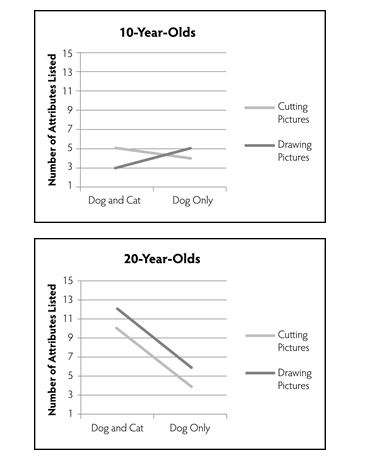Essay
RESEARCH STUDY 11.2
(The first paragraph is repeated from earlier. The second paragraph is specific to the new set of questions. The first paragraph is necessary to set up the original study.)
Dr. Elder was interested in the way people recognize objects as members of categories. For example, what makes us recognize a dog as being a dog and not a cat? More specifically, he was curious as to whether people think about categories in a more complex way if they contemplate an "opposite" category first. For example, does a person think more differently about the category of "southern" if they are also thinking about the category of "northern"? He is also curious as to whether people categorize differently if they are exposed to category members compared with generating category members. Dr. Elder has four groups of participants (with 30 people in each group). In Group A, participants were told to cut out pictures of dogs and cats from magazines. In Group B, participants were told to cut out pictures of just dogs from magazines. In Group C, participants were told to draw pictures of cats and dogs. In Group D, participants were told to draw pictures of just dogs. After doing this for 30 minutes, participants in all groups were asked to list the attributes that define the "dog" category. Having a higher number of attributes listed was considered to be an indication of thinking about the category in a more complex way.
Dr. Elder also is curious as to whether categorization happens similarly for children as it does for adults. As such, he recruits a group of 10-year-olds and a group of 20-year-olds to participate in the study. The results are below.

-Refer to Research Study 11.3 above to answer the following question.
Using the marginal means,state whether it appears that the main effects in Dr.Lopez's study are important.(You do not need to say whether the main effects are statistically significant,but simply whether a difference appears to exist.)
Correct Answer:

Verified
Students should provide the marginal mea...View Answer
Unlock this answer now
Get Access to more Verified Answers free of charge
Correct Answer:
Verified
View Answer
Unlock this answer now
Get Access to more Verified Answers free of charge
Q9: State the three types of factorial designs.
Q34: Imagine that you are reading a journal
Q35: RESEARCH STUDY 11.1<br>Dr. Elder was interested in
Q36: RESEARCH STUDY 11.1<br>Dr. Elder was interested in
Q37: An author might use all of the
Q39: A "difference in the difference between the
Q40: Dr.Gavin decides that instead of conducting a
Q41: RESEARCH STUDY 11.2<br>(The first paragraph is repeated
Q42: What are the two main reasons to
Q43: Dr.Rhodes notices an interaction in his factorial